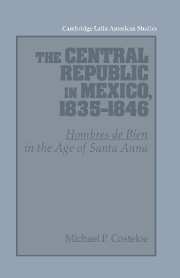Book contents
- Frontmatter
- Contents
- Preface
- Acknowledgements
- 1 An introduction: change and continuity in the Age of Santa Anna
- 2 The end of federalism
- 3 The transition to centralism: stage I
- 4 The transition to centralism: stage II
- 5 Las Siete Leyes
- 6 Anastasio Bustamante and the centralist republic, 1837–1839
- 7 Santa Anna versus Bustamante: the end of the Siete Leyes, 1839–1841
- 8 ‘La dictadura disfrazada con el hermoso nombre de regeneración política’
- 9 Santa Anna and the Bases Orgánicas
- 10 ‘La revolución de tres horas’
- 11 Herrera and the rise of Paredes y Arrillaga
- 12 Hombres de bien and the restoration of federalism
- 13 Conclusion
- Sources and works cited
- Index
- CAMBRIDGE LATIN AMERICAN STUDIES
4 - The transition to centralism: stage II
Published online by Cambridge University Press: 23 October 2009
- Frontmatter
- Contents
- Preface
- Acknowledgements
- 1 An introduction: change and continuity in the Age of Santa Anna
- 2 The end of federalism
- 3 The transition to centralism: stage I
- 4 The transition to centralism: stage II
- 5 Las Siete Leyes
- 6 Anastasio Bustamante and the centralist republic, 1837–1839
- 7 Santa Anna versus Bustamante: the end of the Siete Leyes, 1839–1841
- 8 ‘La dictadura disfrazada con el hermoso nombre de regeneración política’
- 9 Santa Anna and the Bases Orgánicas
- 10 ‘La revolución de tres horas’
- 11 Herrera and the rise of Paredes y Arrillaga
- 12 Hombres de bien and the restoration of federalism
- 13 Conclusion
- Sources and works cited
- Index
- CAMBRIDGE LATIN AMERICAN STUDIES
Summary
On 6 February 1836, José Bernardo Couto, senator for Veracruz, wrote to his exiled friend, Mora, who had retreated to Paris after the fall of the Gómez Farías administration. Couto, together with other friends, took the trouble to write often to keep him up to date with the political and other changes that were taking place during his absence. He explained the latest developments and his own sense of disillusion, which had reached the point that he no longer bothered to attend the Senate. In 1834, he wrote, a coalition of people and opposing interests had been formed to bring about the downfall of the radicals but that had been the only common objective. Once it was achieved, it became clear that there were no firm ideas or plans for the future, and when discussion began on what was to replace the radical programme, ‘everyone has a plan of his own’. Hence, when the issue of the form of government arose and the destruction of the federal charter became certain, many people abandoned the coalition to form a ‘mass of deserters who are wandering about, not knowing what to join’.
When Mora received this letter from Couto, he was in the process of writing his own analysis of the political situation which he was to publish in Paris the following year. Using the information from Couto and other correspondents, he summarized the party political situation as follows. There were four main groups or classes.
- Type
- Chapter
- Information
- The Central Republic in Mexico, 1835–1846'Hombres de Bien' in the Age of Santa Anna, pp. 66 - 92Publisher: Cambridge University PressPrint publication year: 1993



